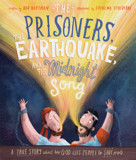
Bob Hartman is a professional storyteller and the author of The Prisoners, the Earthquake and the Midnight Song, the newest book in the Tales that Tell the Truth series. Today he shares his process for retelling Bible stories.
I find that my biggest challenge, when it comes to Bible retellings, is finding a way “in”. A way “in” for me, the writer, and a way “in” for the reader/listener, too.
Sometimes I find it in one of the characters. I read the text. I always read the text. Even if it’s a text I have read a hundred times before. And, sometimes, something about one of the characters jumps off the page and grabs me for the very first time. A physical detail, a comment, an action.

Bible storybook that teaches young children about Jesus’ ongoing power to save and how they can tell their friends about Jesus.
So I let that “something” take me where it will. And eventually I have a different kind of retelling. Sometimes it has to do with the conflict. I have a friend who won’t buy any versions of Jonah that finish with the repentance of the Ninevites, because she reckons (rightly, I think) that leaving out what follows—Jonah’s resentment at the Ninevites’ repentance—misunderstands the conflict completely. And the story with it.
And then, sometimes, the way “in” arrives courtesy of the setting. That was definitely the case when I wrote The Prisoners, the Earthquake and the Midnight Song. I had told the story of Paul and Silas and their miraculous escape from prison several times before. But I had never noticed how many sounds there were in the story. And once I started listening for those sounds—as opposed to looking for physical details—I discovered that those sounds could carry me through the whole of the story!
The first sound? The log-sawing snores of the sleeping jailer. A sound that sets the prison scene and the middle-of-the-night timing of the story. The next sound! Singing, of course! In place of the moaning and groaning and complaining one might expect of two men wrongly locked up in stocks, simply because they had freed a slave girl from her demon. A rumbling, grumbling sound follows, the beginnings of an earthquake that will shatter those stocks and set every prisoner free. And then—oh, dear!—there is the scraping sound of a sword being drawn from a scabbard. For the jailer is wide awake now, and knows that his own life will be forfeit should the prisoners escape. With that comes the sound of gentle sobbing as he considers what that will mean for him and for his family.But before he can put that sword to use, he is interrupted by another sound. Paul is calling, calling out to assure the jailer that none of the prisoners has escaped. And it is the splashing, splashing sound of water that follows. The water the jailer uses to wash the wounds of Paul and Silas. And the water that Paul uses to wash the jailer and his family in baptism. Then, finally, there is more singing, because that whole family now has a reason to praise God along with Silas and Paul!
Now, it’s one thing to build a story around sounds. But how do you illustrate that, if the story is meant to be a picture book?
Cleverly, the illustrator of this particular book, Catalina Echeverri, came up with a series of visual clues that bring each of those sounds to life! I am constantly amazed at what a good picture book artist can accomplish. And Catalina has excelled herself in this case.
What is more, she has created a simple set of icons to illustrate what is perhaps the most important set of sounds in the story. You see, at every stage of the story, Paul and Silas have the opportunity to talk about Jesus - how he died so we can be forgiven, and rose from the dead so that we can live forever, and sent his Holy Spirit so we can follow him as our king.
They share that good news with the slave girl, and the other prisoners, and with the jailer and his family. And so we see those sounds come to life, as well, throughout the retelling, and through three simple icons. And then, finally, the reader is encouraged to make some sounds of their own - to pass that same good news to anyone who will listen—with those three simple icons in mind.
So how do I retell a Bible story? I always read. I always look. I always consider the problem of the story. But, sometimes, there is a whole lot more to be gained simply by listening!
The Prisoners, the Earthquake and the Midnight Song by Bob Hartman teaches children about Jesus’ ongoing power to save through the proclamation of the gospel and through the presence of the Holy Spirit. It is available to buy here.